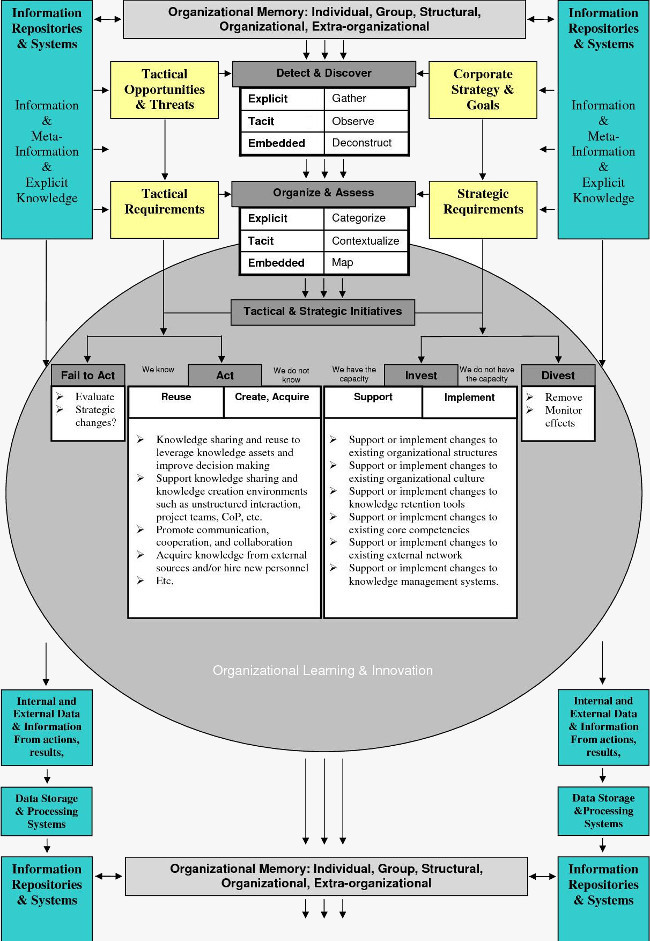The integrated knowledge management model that I have created combines the main aspects of the topics discussed on this site into a model that focuses on the strategic perspective. The integrated knowledge management model attempts to link both process and strategy, while offering specific initiatives at different stages. The model also outlines the relationship of information and information management systems to knowledge management (KM).

The integrated knowledge management model draws upon elements presented by Bukowitz & Williams, Gamble & Blackwell, Botha et al, and Nonaka & Takeuchi. It also includes the concept of organizational memory as defined earlier.
The dark gray elements represent KM initiatives, the yellow boxes represent corporate strategy, while the teal boxes depict data and information systems and repositories. The process is initiated from the tactical and strategic considerations, illustrating the way KM strategy goes hand in hand with corporate strategy. The non-bolded elements in the gray oval indicate the knowledge related processes that go on within the organization as it operates, and which management affects/enhances through its initiatives.
- Detect & Discover: Search for existing knowledge as well as hidden knowledge within information and data.
- Organize & Assess: Organization and assessment of knowledge assets. Knowledge is categorized, evaluated, and made easier to access (by providing maps etc.).
- KM Tactical initiatives:
- Act - Reuse: If the firm can use existing knowledge to meet a tactical opportunity or threat, the role of KM is to identify this knowledge and enable it to be used. This means that if it is required by a different person/group, then KM is responsible for making it available to all relevant parties.
- Act - Create/acquire: If the right knowledge resources do not exist, the firm may create or acquire them, assuming the right processes and systems are in place to support this. For example, the knowledge may be acquired from partners if the right relationships are in place. knowledge creation depends on the right internal environments that allow for combination and conversion of knowledge assets.
- Failure to act: This is not really a KM initiative in itself, but it does have some implications. In the event that a firm fails to act there is still a lesson to be learned. Management must evaluate if this is something that needs to be addressed in the future. This decision is fed back into the loop, affecting future strategic choices.
- KM Strategic Initiatives:
- Invest: Support or implement. Here I refer to the organizational structures, culture, knowledge retention, competencies, external network, and systems that direct, affect, and/or enable the KM initiatives discussed above in the long term. Strategic initiatives may, for example, involve creating a knowledge sharing culture, restructuring the firm, establishing a beneficial partnership, or implementing a new IT system. If the right environment, system, etc. is already in place, management must make sure to continuously support it. It is important to note that some of these do not fall solely within KM, and they are all fields of study in their own right. However in this case, we are interested solely in the way these broader strategic initiatives shape the focus and direction of KM in the long term.
- Divest: When knowledge assets become obsolete they need to be removed. KM is responsible for maintaining relevant knowledge assets.
The differentiation between tactical and strategic initiatives should not be seen as categorical, and in reality projects and initiatives will often have mixed goals. The integrated knowledge management model itself should be seen as continuously looping, with new or modified knowledge and information being fed into organizational memory and information repositories each time.
All processes are thus supported by information systems. They play an important role in tracking progress and feeding that information back into the system. This way, each time the integrated knowledge management model is run, it is based on different information, understanding, knowledge, and circumstances than the last time. As with all sequential models, none of this should be taken absolutely literally.
Although this is called an "integrated" knowledge management model, it is not intended to be all-encompassing. Since KM is such a broad discipline, one could continue to add elements until the model was so complex that it had no meaning.
Conclusion
In this section and the preceding ones, I have looked at various KM models and presented my version of an integrated knowledge management model.
Although not intended to represent all possible areas, the integrated knowledge management model does cover the major requirements of a model as defined earlier. To recap, these are:
- Identification of needs
- Identification of knowledge resources
- Acquisition, creation, or elimination of knowledge related resources/processes/environments
- Retrieval, application and sharing of knowledge
- Storage of knowledge
It also addresses (at least to some degree) the 3 main approaches to knowledge management, also outlined in earlier sections, namely: what/how, why, when. Finally, the model ties in information, strategy, and organizational memory, building on the work of past authors.
The following section will knowledge managmenent processes and knowledge management strategy in-depth. The section will be modelled after the categories presented in this integrated knowledge management model.
